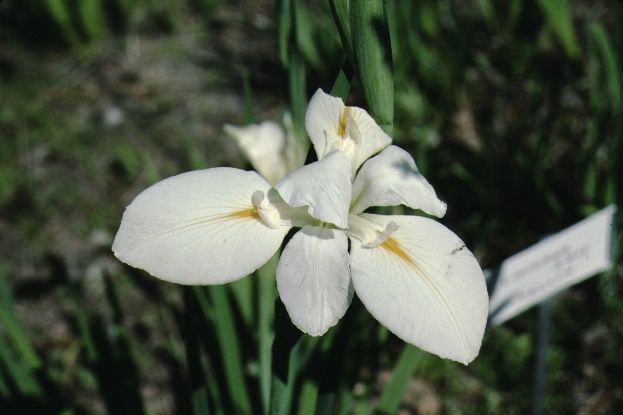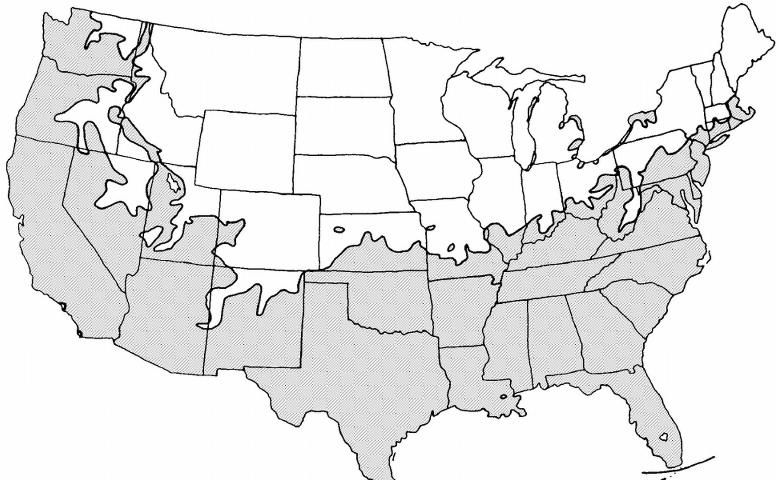Introduction
Louisiana iris hybrids (also Iris breuicaulis, Iris giganticaerulea) have dark green, sword-like leaves and rhizomatous roots. They grow 2 to 4 feet tall and bear 3 to 4inchlong flowers of white, cream, yellow, bronze, pink, red, blue, purple, or near black. These spring flowers are often cut for flower arrangements. Louisiana iris hybrids are clumping, spreading, or upright perennials that can be used as background or specimen plants. They are also useful in a mass planting.

Credit: Edward F. Gilman, UF/IFAS

Credit: Edward F. Gilman, UF/IFAS
General Information
Scientific name: Iris fulva 'Louisiana hybrids'
Pronunciation: EYE-riss FULL-vuh
Common name(s): Louisiana iris
Family: Iridaceae
Plant type: herbaceous; ground cover
USDA hardiness zones: 6 through 10 (Figure 3)
Planting month for zone 7: year round
Planting month for zone 8: year round
Planting month for zone 9: year round
Planting month for zone 10: year round
Origin: native to Florida
Invasive potential: not known to be invasive
Uses: border; mass planting; ground cover; edging
Availability: somewhat available, may have to go out of the region to find the plant

Credit:
Description
Height: 2 to 3 feet
Spread: 2 to 3 feet
Plant habit: upright
Plant density: moderate
Growth rate: moderate
Texture: coarse
Foliage
Leaf arrangement: most emerge from the soil, usually without a stem
Leaf type: simple
Leaf margin: entire
Leaf shape: linear
Leaf venation: parallel
Leaf type and persistence: semi-evergreen; evergreen
Leaf blade length: 12 to 18 inches
Leaf color: green
Fall color: no fall color change
Fall characteristic: not showy
Flower
Flower color: white; red; yellow; pink; purple; cream; bronze; blue; near black
Flower characteristic: spring flowering
Fruit
Fruit shape: unknown
Fruit length: unknown
Fruit cover: unknown
Fruit color: unknown
Fruit characteristic: inconspicuous and not showy
Trunk and Branches
Trunk/bark/branches: not applicable
Current year stem/twig color: not applicable
Current year stem/twig thickness: not applicable
Culture
Light requirement: plant grows in part shade/part sun
Soil tolerances: acidic; sand; loam; clay
Drought tolerance: high
Soil salt tolerances: unknown
Plant spacing: 24 to 36 inches
Other
Roots: not applicable
Winter interest: no special winter interest
Outstanding plant: plant has outstanding ornamental features and could be planted more
Pest resistance: long-term health usually not affected by pests
Use and Management
Louisiana iris hybrids grow best in a full sun to partially shaded location in the landscape. They require an acidic soil in the range of 5.5 to 6.5 and prefer moist soils with high organic matter content. They will grow in a sandy soil that receives some irrigation in prolonged dry spells. These hybrids are tolerant to drought but will also endure wet soils. These plants are frozen to the ground in freezing temperatures but will regenerate from the roots with the onset of warm weather.
Propagate these hybrids by division or from seed.
Pests and Diseases
Louisiana iris hybrids are pest tolerant.